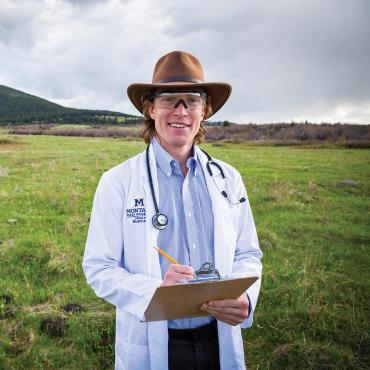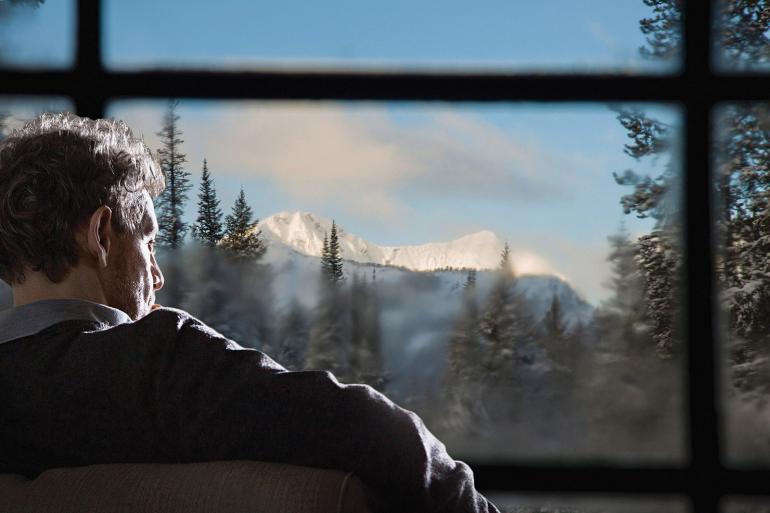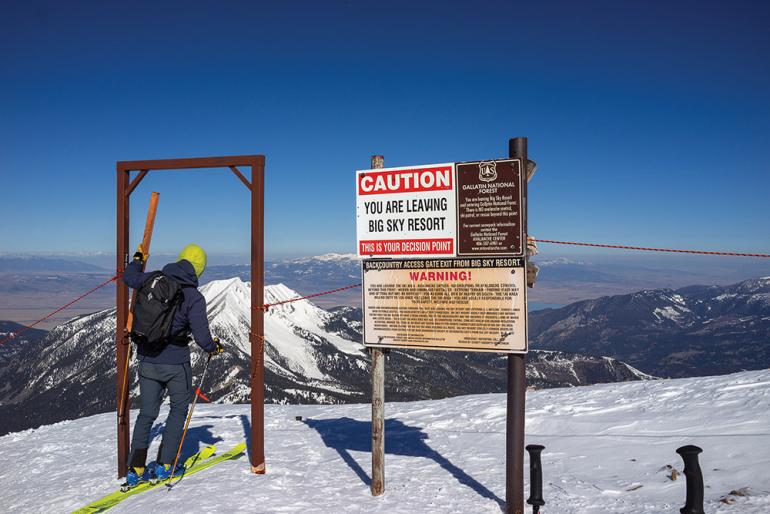Flown Away
The story of a life-changing turn.
The day started like any other Saturday in mid-April: alarm sounding at six, coffee dripping in the pot, clear blue skies, a big day planned. Spring skiing was in full swing, and we decided to take advantage of the last weekend that lifts would be turning at Big Sky to access a mighty objective: the east face of Fan Mountain. It stands tall between Lone Peak and the Madison Valley, and any skier who’s caught a glimpse has surely dreamt of skiing it in the right conditions. We were going to have it in spades.
I’d been training all winter for a trip to Denali, where I’d be on the crew for a segment in an upcoming Warren Miller film—sure to gain me some notoriety. Excitement for the trip bourgeoned with each coming week and I was exhuming that energy with every outing—boundless energy that would all-too-soon get away from me.
We stepped off the tram and gave a nod to the patroller manning its summit station. “Have fun,” he hollered, as we slid past the ski-resort boundary. “You’ve got a perfect day for it.”
Descending the west ridge of Lone Peak should’ve been the low point; the wind-scoured snow was all but unskiable, and we ended up walking most of the way. Once below treeline, the substrate improved and we linked a few nice turns into the Lee Metcalf Wilderness before slapping on skins for the ascent. We filled our water bottles in the South Fork of Jack Creek and toasted to another epic day.
The climbing started out hot. I was rip-roaring to get up that ridge as fast as I could and sail down the face like a diving falcon—not to mention the sun beating down on us, too. My partner—less conceited than I—chuckled as I blasted ahead. Curiously, a set of ski tracks appeared ahead of us, faintly at first but becoming more prominent as we climbed above the refrozen snow. No way is anyone else tracking up that face before me today, I thought. The fire raged.
I asked my partner to pull out his iPhone and take a video of me tearing down the apron—a self-administered dose of Kodak courage.
I caught the pair before long, but the effort was vain—my partner just wasn’t so bothered by the premise of getting scooped. He was enjoying the clear air and scenery; I had my head down and barely looked more than five feet ahead the entire way up. Eventually, all four of us stood on the summit together, shared some high-fives, and decided to ski down as a group.
I dropped in last to get a good camera angle on the other three taking off. The first few turns were dicey, but soon we were gliding through boot-top powder on a deceivingly steep slope. With no trees and few rocks for reference, the line was visually compressed—like looking down an open highway through a telephoto lens. Each section that appeared to be five turns long turned out to be 20. It seemed like this run would keep going on and on, forever. Past all the major obstacles, the other pair bid us farewell and skied down to treeline. I asked my partner to pull out his iPhone and take a video of me tearing down the apron—a self-administered dose of Kodak courage.
The next moments, for better or worse, are seared into my memory like a brand on a yearling. I made wide-open turns down the shallow, shaded gully filled with soft, dry snow. Approaching Mach 1, I hit the apron that had been baking in the sun all day, where powder gave way to wet, heavy slush. Oh shit, I recall thinking. Should I shut it down? I could have banked a rightward traverse and dumped all my speed, then reset to make smaller turns down the rest of the face. But I remembered that the camera was on me. Fuck it. One big arcing turn and I was approaching the threshold of control. Another and I’d completely lost it. On the third, as I pressed into that downhill ski without a split-second to consider what was about to happen, my whole world turned upside-down.
I still wake up in cold sweats, reliving those few seconds of tumbling down Fan Mountain.
Thwack! Then right-side up again. Snap, crackle, pop! Upside-down. With each tumbling cycle I felt cartilage shredding inside my left knee. I was flipping so fast my vision blacked out from the blood rushing to my head. After a dozen cartwheels, I lay face-up in the snow and the world began to lighten again. I saw one ski still attached to my left foot; the other ski and my poles were nowhere to be seen. Little did I know as I sat quivering in fear, my knee ballooning to twice its normal size, that I was on the precipice of a monumental shift in lifestyle and perspective. I knew right away that I wouldn’t be leaving for Alaska in a month, but that was just beginning of what I’d be missing.
It was obvious that I wasn’t getting out under my own power. I couldn’t even sit up without howling in pain as my unstable knee shifted around, let alone skin 1,500 feet uphill to the base of Six-Shooter in time for last chair. The other pair of skiers saw my crash and skinned back up to help. We were lucky to have a bar of cell service and got a spotty call through to Gallatin County Search & Rescue. Discussing our options with the dispatcher, we concluded that a heli-evac was in order. We could’ve asked for a vehicle to meet us on Jack Creek Road, but we had no idea how long it’d take for us—or for help—to get there. And at that point, the top priority was preventing the other three from getting caught out in the dark.
Thankfully, we all had some wilderness-medicine training. Turns out, all those times practicing makeshift splints out of clothing and little pieces of cord weren’t for naught. We packed an extra jacket around my swollen joint, and luckily, one of the other skiers had a SAM splint in his backpack to bolster it. I never would’ve thought I’d use a SAM splint in the backcountry, but that extra rigidity might’ve been a deal-breaker between getting down the rest of the slope by myself and needing a rescue in situ.
I popped up onto my good leg and the splint felt solid. On the slopes above us, beaming sunlight was causing wet-loose slides to release from the steepest points. It was time to get out of there. I zig-zagged back-and-forth in a falling-leaf pattern down the rest of the face, forward and backward, keeping my right ski downhill. After nearly an hour we reached a flat, open meadow where the helicopter could land. We decompressed, cracked a few jokes to lighten the mood, and before long, heard rotors beating the air. I skied to the door on one leg and we took off. Soaring above the Spanish Peaks, morphine drip administered, I took one last glance at those snow-covered slopes that would exist only in my imagination for quite some time.
A CT scan revealed multiple tibial plateau fractures, and an MRI showed a torn PCL and meniscus. I was to undergo surgery at the soonest availability, which, in springtime in Bozeman (a.k.a., knee-injury season) was not very soon. A month after my accident, a surgeon chopped out the tattered PCL, installed a new one from a cadaver, and sutured my meniscus back in place. I woke up with a new standard for the “worst pain in my life.”
As spring turned to summer, weeks turned to months, my frequent adventure buddies turned to occasional at-home companions, and—yes, it’s dramatic—I lost my sense of purpose in life. Everything I had grown to love; everything that I thought could fulfill me—a predawn start to an all-day mission, getting winded on steep switchbacks, hootin’ and hollerin’ under a clear sky, spectacular views, sore feet, aching muscles, resilience, and clinking beers when it’s over—was ripped away by my own lapse in judgement, my egotism, my hubris. No, I’m not being hard on myself; this was too easily preventable—if only I’d had the wherewithal to slow down.
Instead of reading the route on an alpine climb, I learned to read rapids on a river. I read more books. I put more effort into my job and it has paid off.
They say it’ll all be in the rear-view mirror one day, but nine months later, it’s not. PCL reconstructions aren’t your bread-and-butter knee surgery—it’s an uncommon procedure and complications are keeping me out of the mountains still. And if that doesn’t mandate humility, I don’t know what will. I still wake up in cold sweats, reliving those few seconds of tumbling down Fan Mountain. I wish that it hadn’t happened, and I hope that it never happens to anyone else, and that’s why I’m telling this story.
But I’m also telling this story because it doesn’t have a sad ending. We are beings of stasis—we adapt to circumstances, recalibrating to the new normal. And as much as it irks me to say it, I’m still happy living on flat ground. That energy to keep pushing is still inside me, and channeling it toward something, anything, is fulfilling all the same. Instead of reading the route on an alpine climb, I learned to read rapids on a river. I read more books. I put more effort into my job and it has paid off—I’m still here, after all. I’ve spent more time with my family this year than I have since leaving for college eight years ago. I’ve redefined my purpose with a new understanding of what’s in my control and what’s not. I’m not the only one who has gone through this—we all have, in some way or another, experienced profound grief. But we can all look around and say, “Some have it better, some have it worse.” That’s easy to lose sight of in a fast-paced outdoor lifestyle, where we measure our worth by the difficulty of our pursuits. So take it from me: slow it down a notch, partner, take a look around you, and realize how lucky you are to be here. And when I’m back skiing again, someday, that is how I’m going to feel.











